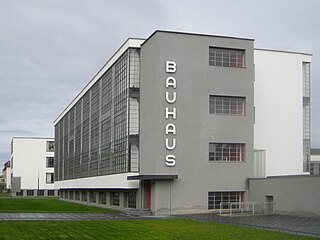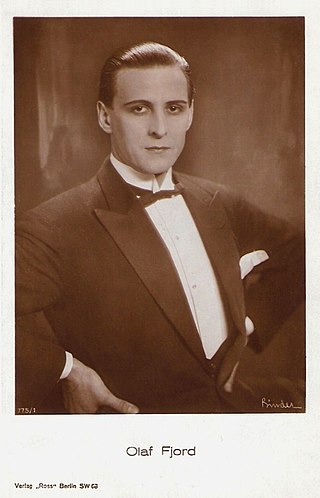Related Research Articles

Weimar culture was the emergence of the arts and sciences that happened in Germany during the Weimar Republic, the latter during that part of the interwar period between Germany's defeat in World War I in 1918 and Hitler's rise to power in 1933. 1920s Berlin was at the hectic center of the Weimar culture. Although not part of the Weimar Republic, some authors also include the German-speaking Austria, and particularly Vienna, as part of Weimar culture.

Georg Wilhelm Pabst was an Austrian film director and screenwriter. He started as an actor and theater director, before becoming one of the most influential German-language filmmakers during the Weimar Republic.

The New Objectivity was a movement in German art that arose during the 1920s as a reaction against expressionism. The term was coined by Gustav Friedrich Hartlaub, the director of the Kunsthalle in Mannheim, who used it as the title of an art exhibition staged in 1925 to showcase artists who were working in a post-expressionist spirit. As these artists—who included Max Beckmann, Otto Dix, George Grosz, Christian Schad, Rudolf Schlichter and Jeanne Mammen—rejected the self-involvement and romantic longings of the expressionists, Weimar intellectuals in general made a call to arms for public collaboration, engagement, and rejection of romantic idealism.

German Expressionism consisted of several related creative movements in Germany before the First World War that reached a peak in Berlin during the 1920s. These developments were part of a larger Expressionist movement in north and central European culture in fields such as architecture, dance, painting, sculpture and cinema. This article deals primarily with developments in German Expressionist cinema before and immediately after World War I, approximately from 1910 to the 1930s.

Westfront 1918 is a German war film, set mostly in the trenches of the Western Front during World War I. It was directed in 1930 by G. W. Pabst, from a screenplay by Ladislaus Vajda based on the novel Vier von der Infanterie by Ernst Johannsen. The film shows the effect of the war on a group of infantrymen portrayed by an ensemble cast led by screen veterans Fritz Kampers and Gustav Diessl.
Fritz Arno Wagner is considered one of the most acclaimed German cinematographers from the 1920s to the 1950s. He played a key role in the Expressionist film movement during the Weimar period and is perhaps best known for excelling "in the portrayal of horror" according to noted film critic Lotte H. Eisner.

Olaf Fjord was an Austrian actor, film director and film producer.

Anton Pointner was an Austrian stage and film actor. Pointner's career began on the stages of Austria and performed in both silent and sound films in his native Austria, as well as in Germany and the United States.

Tannenberg is a 1932 Swiss–German war film directed by Heinz Paul and starring Hans Stüwe, Käthe Haack and Jutta Sauer. The film is based on the 1914 Battle of Tannenberg during the First World War. It focuses on a German landowner Captan von Arndt and his family.
Helga Amalia Thomas was a Swedish film actress.
Manfred Noa was a German film director. Noa was described by Vilma Bánky, who he directed twice, as her "favourite director". Noa's 1924 film Helena has been called his "masterpiece" although it was so expensive that it seriously damaged the finances of Bavaria Film.
Eduard Hoesch was an Austrian cinematographer and film producer.
Scapa Flow is a 1930 German drama film directed by Leo Lasko and starring Otto Gebühr, Claire Rommer and Claus Clausen. It is set around the Wilhelmshaven Mutiny and the Scuttling of the German fleet in Scapa Flow at the close of the First World War. In Weimar Germany the scuttling of the fleet in defiance of the victorious Allies had come to be seen as a popular patriotic act. The inclusion of the Mutiny, however, was more controversial as it highlighted the political divisions which continued to exist. The film was praised by the right wing press, and comparisons were made to the Russian film Battleship Potemkin. The film was partly inspired by the 1918 play Seeschalt by Reinhardt Goering.
Edgar Ziesemer (1895–1971) was a German cinematographer.
Henry Stuart was a Swiss film actor known for his work in Germany. Stuart was born in Cairo as son of a Swiss doctor, but educated in Britain. He attended the Academy of Fine Arts in Munich, intending to become a painter. After moving into the German film industry following the First World War, Stuart played a number of prominent supporting roles in productions such as Joyless Street (1925). Stuart's film career largely ended with the arrival of sound, and he worked increasingly on the stage. His final film appearance was a small role in the Nazi agfacolor epic Münchhausen (1943).
The Mystery of Bangalore is a 1918 German silent film directed by Alexander Antalffy and Paul Leni and starring Conrad Veidt, Gilda Langer and Harry Liedtke. It is a lost film.

Iwa Wanja was a Bulgarian actress based in Germany. She moved to Berlin to pursue her career, appearing in around thirty German films. Married to Norbert Schultze, German composer, best remembered for having written the melody of the World War II classic Lili Marleen.
Viktor Gluck was a German cinematographer who worked on thirty three films between 1923 and 1934.
Liddy Hegewald (1884–1950) was a German film producer of the silent and early sound eras. She controlled her own production company Hegewald Film.
Viktor Senger (1870–1942) was a German stage and film actor.
References
- ↑ MoMA|German Expressionism Style: New Objectivity
- ↑ Cultural changes: developments in architecture, art and the cinema - The Weimar Republic 1918-1929 - Edexcel - GCSE History Revision - Edexcel - BBC Bitesize
- ↑ Film Front Weimar: Representations of the First World War in German Films of ...by Bernadette Kester, page 123
- ↑ Private Anxieties/Public Projections: "New Objectivity", Male Subjectivity, and Weimar Cinema on JSTOR
- ↑ Weimar Cinema: An Essential Guide to Classic Films of the Era, edited by Noah William Isenberg, page 140
- ↑ Film Front Weimar: Representations of the First World War in German Films of ...by Bernadette Kester, page 123
- ↑ Westfront 1918 (1930)|The Criterion Collection
- ↑ The Ufa Story: A History of Germany's Greatest Film Company, 1918-1945, by Klaus Kreimeier, page 113
- ↑ New Objectivity - Didactics_0.pdf
- ↑ Weimar Cinema: An Essential Guide to Classic Films of the Era, edited by Noah William Isenberg, page 140
- ↑ Isenberg, Noah, ed. (2009). Weimar Cinema: An Essential Guide to Classic Films of the Era. Columbia University Press. p. 236. ISBN 9780231503853 . Retrieved February 2, 2023– via Google Books.
- ↑ Film Front Weimar: Representations of the First World War in German Films from the Weimar Period (1919-1930) on JSTOR
- ↑ An Endless Number of Great Deeds: Film Front Weimar: Representations of the First World War in German Films of the Weimar Period (1919-1933) by Bernadette Kester — Senses of Cinema